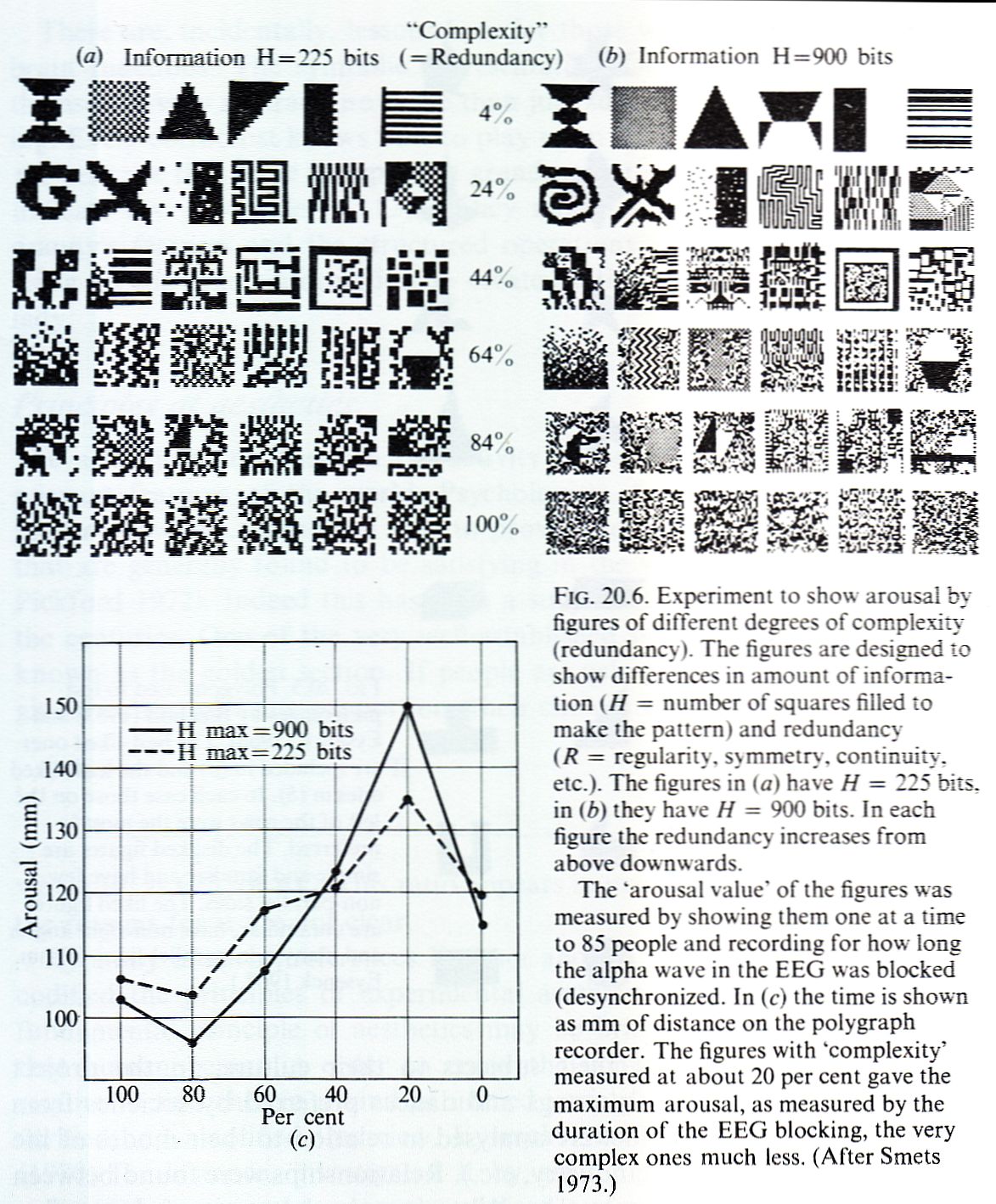
Link to the image described in the text;
https://reanimater.tripod.com/art_complexity.html
Experiment to show arousal by figure of different degrees of complexity (redundancy). The figures are designed to show differences in amount of information (H = number of squares filled to make the pattern) and redundancy (R = regularity, symmetry, continuity, etc.)... In each figure the redundancy increases from above downwards.
The arousal value of the figures was measured by showing them one at a time to 85 people and recording for how long the alpha wave in the EEG was blocked (desynchronized...)
THe figures with complexity measured at about 20 per cent gave the maximum arousal, as measured by the duration of the EEG blocking, the very ones much less.
Programs of the brain.
J. Z. Young 1978
http://www.amazon.co.uk/exec/obidos/ASIN/0198575459/
In defence of the resonance proposition, Smets (1973) found that psychological arousal was greatest when the redundancy-repetitiveness of design elements was about 20 per cent — this is equivalent to the amount of order found in a simple maze, in two complete turns of a logarithmic spiral, or a cross with asymmetrical arms. This phenomenon seems to be innate as drawings with this degree of order tend to be viewed longer by new-born infants.
http://mc2.vicnet.net.au/home/cognit/web/hodgson.html
Research on cognitive development has shown that in the course of its growth the mind probes certain channels much more readily than others. Some of the responses are automatic and can be measured by physiological changes of which the individual is mostly or entirely unaware. For example, using electroencephalograms in the study of response to graphic designs, the Belgian psychologist Gerda Smets found that maximal arousal (measured by the blockage of the alpha wave) occurs when the figure contains about 20 percent redundancy (1973). That is the amount present in a spiral with two or three turns, or a relatively simple maze, or a neat cluster of ten or so triangles. Less arousal occurs when the figure consists of only one triangle or square, or when the design is more complicated than the optimum—as in a difficult maze or an irregular scattering of twenty rectangles. The data are not the result of a chance biochemical quirk. When selecting symbols and abstract art, people actually gravitate to about the levels of complexity observed in Smet's experiments. Furthermore, the preference has its roots in early life. Newborn infants gaze longest at visual designs containing between five and twenty angles. During the next three months their preference shifts toward the adult pattern measured with electroencephalograms. Nor is there anything foreordained or otherwise trivial in the aesthetic optimum of human beings. It is easy to imagine the evolution of some other intelligent species in another time or on some other planet, possessing different eyes, optic nerves, and brain—and thus distinct optimal complexity and artistic standards.
We can reasonably suppose that the compositions of artists play upon the rules of mental development that are now beginning to receive the objective attention of experimental psychology. The distinction between science and art can be understood more clearly from this different perspective. The abstracted qualities of the developmental rules of the mind are the principal concern of science. In contrast, the node-link structures [of long-term memory] themselves, their emotional color, tone, cadence, fidelity to personal experience, and the images they fleetingly reveal, are more the domain of art. Of equal importance to both enterprises are the symbols and myths that evoke the mental structures in compelling fashion. Certain great myths—the origin of the world, cataclysm and rebirth, the struggle between the powers of light and darkness. Earth Mother, and a few others—recur dependably in cultures around the world. Lesser, more personal myths appear in crisis poems and romantic tales, where they blend imperceptibly into legend and history. Through the deep pleasures they naturally excite, and the ease with which they are passed from one person to another, these stories invade the developing mind more readily than others, and they tend to converge to form the commonalities of human nature. Yeats in his 1900 essay on Shelley distinguished between the theoretician who seeks abstract truth and the naturalist-poet who celebrates detail. In the universe of the mind, Yeats said, no symbol tells all its meanings to any generation. Only by discovering the ancient symbols can the artist express meanings that cross generations and open the full abundance of nature.
http://www.worldandi.com/subscribers/feature_detail.asp?num=24196